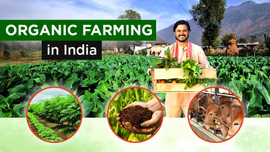Sunflower Cultivation in India: A Complete Guide for Farmers

Sunflower is an important oilseed crop in the world. It is used for a variety of purposes and highly valued for its health benefits. It is also known as the "Champion" of the oilseed crops. This article explores sunflower farming in India, covering its different varieties and the agricultural practices essential for successful cultivation.
Table of Contents
- Introduction
- Sunflower Cultivation in India
- Varieties of Cultivated in India
- Step by Step Guide to Successful Sunflower Cultivation
Introduction
Sunflower (Helianthus annuus L.) is an important oilseed crop in India, popularly known as "Surajmukhi." Its name is derived from the Greek words 'Helios', meaning 'sun' and 'anthos', meaning 'flower'. Young sunflowers often exhibit heliotropism, meaning they follow the direction of the sun and turn towards direct sunlight. In India, Sunflower production is mainly done for the extraction of edible oil. Sunflower seeds contain about 48–53 per cent edible oil. Sunflower oil is also considered a premium option compared to other vegetable oils, as it contains linoleic acid (an omega-6 fatty acid) and oleic acid (a monounsaturated fatty acid), both of which are considered low in cholesterol and beneficial for heart health. Sunflower seeds are a good source of vitamin E, healthy fats, and various minerals, including magnesium and zinc and are used as nutritious feed for birds and animals. It is also used in the preparation of cosmetics and pharmaceuticals.
Sunflower Cultivation in India
Sunflower cultivation in India began in the 1960s as a response to the growing demand for edible oils. It was introduced as an alternative oilseed to help meet the country's increasing consumption needs. Today, India is the fourth-largest oilseed-producing country in the world, accounting for 10 per cent of global oilseed production.
Between the years 2020–21, sunflower production in India covered an area of 0.23 million hectares, yielding a total production of 0.23 million tonnes with an average yield of 1,011 kilograms per hectare. In 2021–22, according to the 4th Advance Estimates from the Department of Agriculture and Farmers Welfare (DA&FW), the area under oilseed cultivation increased to 0.28 million hectares, resulting in a production of 0.25 million tonnes. The Indian states of Karnataka, Telangana, and Odisha are among the top sunflower seed-producing states in the country.
Major Sunflower Producing States in the Country
Below we have listed some of the highest sunflower production states in the country.
|
State |
Area (Mha) |
% of All India Area |
Production (Mt) |
% of All India Production |
|
Karnataka |
0.16 |
58.41 |
0.14 |
54.35 |
|
Telangana |
0.02 |
6.45 |
0.02 |
8.32 |
|
Odisha |
0.02 |
5.50 |
0.02 |
7.56 |
|
Haryana |
0.01 |
3.01 |
0.02 |
6.40 |
|
Maharashtra |
0.03 |
9.53 |
0.01 |
5.59 |
|
Andhra Pradesh |
0.02 |
7.17 |
0.01 |
4.77 |
|
Others |
0.03 |
9.94 |
0.03 |
13.01 |
* E&S Division, DA&FW (Area, Production and Yield during 2021-22)
Varieties of Sunflower Cultivated in India
There are different varieties of sunflower grown in India. Some of them include:
|
Varieties |
Year of Release |
Areas of Adaptation/recommended ecology |
Seed yield (kg/ha) |
Oil Content (%) |
|
EC-68415 |
1976 |
Karnataka |
800-1000 |
36-39 |
|
Morden |
1978 |
All sunflower growing states of |
600-800 |
34-35 |
|
Surya |
1982 |
Maharashtra |
1000-1200 |
35-38 |
|
CO-1 |
1983 |
Tamil Nadu |
600 - 900, (rainfed) / 800 - 1000 (irrigated) |
35-38 |
|
CO-2 |
2010 |
Tamil Nadu |
1800 (Kharif) / 2150 (Rabi) |
38-40 |
|
Kanthi |
2010 |
Zone 1 & 2 of Karnataka |
1200 - 1400 |
39-42 |
|
Bhanu |
2010 |
Zonal Agricultural Research Station, |
1600 - 1800 |
37-39 |
Step by Step Guide to Sunflower Cultivation
Here are the 09 essential steps for successful Sunflower cultivation
1. Climate and Soil Requirement
Sunflower is adaptable to a wider soil and climatic conditions. Ideally, this crop requires a cool climate during germination, warm weather from the seedling stage up to flowering and clear, sunny days during flowering to maturity. Sunflower seeds begin to germinate at around 4°C, but a temperature range of 8°C to 10°C is ideal for good germination. It requires less than 50 cm of rainfall, making it suitable for areas with moderate water availability. In India, sunflowers are cultivated in both the Kharif and Rabi seasons, depending on the region and climate.
The crop grows well in deep, neutral, and well-drained light soils, as well as in heavy soils. The pH requirement of the soil for this crop is between 6.5 and 8.5. Low-level and marginal fertility soil is not suitable for cultivation.
2. Land Preparation
Successful germination and growth of the crop requires good land preparation. In the case of light soil, ploughing should be done once or twice, followed by planking and harrowing. When the soil is medium to heavy, harrowing should be done at least twice. Soil should be moist to a depth of at least 10 cm before sowing, which requires strong soaking rains or irrigation. The seedbed should have a fine tilth before sowing begins.
3. Sowing, Seed Rate & Seed Treatment
Sunflower is sown during the Kharif season, from the second fortnight of June to mid-July in light soils, and up to the second fortnight of August in heavy soils. In the Rabi season, it can be sown from September to the end of November. Sowing should be avoided during drizzles or cloudy weather, as it affects seed germination. Use 5-6 kg/ha seed for rainfed crops and 4-5 kg/ha for irrigated crops.
Seeds should be sown in rows, approximately 4–5 cm deep, preferably following the ridge and furrow method. Maintain a row spacing of 45 X 30 cm (in light soil) and 60 X 30 (heavy soil), and thin the plants to keep 15 cm spacing between them. This should be done before the first irrigation, around 15–20 days after sowing.
To defend against seed-borne illnesses, treat the seed with 3g of thiram or captan per kilogram of seed. In regions where downy mildew is known to be present, treat seed with metalaxyl at a rate of 6g/kg seed.
4. Fertilizer Management
Before Sowing: Mix 7 tonnes per hectare of well-decomposed FYM or compost into the soil. Do this 2–3 weeks before sowing. Always decide the amount of fertilizer to use based on your soil test results.
Fertilizer Dose:
- For rainfed crops: Use 60:60:30 NPK.
- For irrigated crops: Use 60:90:30 NPK.
How to Apply NPK:
Apply 50% Nitrogen (N) + 100% Phosphorus (P) + 100% Potassium (K) at the time of sowing (basal). Apply the remaining 50% Nitrogen in two equal parts:
- First at 30 days after sowing (DAS)
- Second at 55 days after sowing
Phosphorus Tip: Use SSP (Single Super Phosphate) as it also supplies Sulphur (S).
Sulphur (S): If soil lacks Sulphur, apply 25 kg/ha of gypsum.
Boron (Micronutrient):
- Apply borax @ 2 g per litre of water as a spray at the star bud stage.
- First, dissolve borax in hot water, then make the total volume up to 500 litres per hectare for spraying.
5. Irrigation
Irrigate the sunflower crop every 8–10 days in light soils and every 15–25 days in heavy soils. It is especially important not to skip irrigation during critical growth stages such as:
- Bud initiation (34–40 days after sowing)
- Flower opening (55–65 days)
- Seed filling (65–80 days)
Lack of moisture during these stages can lead to a significant drop in yield.
6. Weed Management & Intercropping System
During sunflower cultivation, it is best to start with pre-emergence herbicides like Fluchloralin at 2.0 L/ha (or Pendimethalin around 1 kg a.i./ha) applied just before sowing or within a few days afterwards. It should be followed by hand/weeding or hoeing twice, which can be done once around 15–20 days and again at 30–35 days after sowing to keep the field clean and improve aeration.
Effective intercropping practices such as pairing sunflower with short duration legumes like green gram (moong), black gram (urad), pigeon pea, groundnut, or even soybean can be great for increasing productivity. According to AICRP recommendation, sunflower + groundnut (3:1), Pigeonpea + Sunflower (2:1/1:1/1:2) and soybean + sunflower (2:1) are successful combinations that enhance yield and resource use efficiency.
7. Pollination
Sunflowers rely heavily on cross-pollination, meaning pollen must come from varieties of Sunflower plants for good seed set, oil content, and yield. Insects, especially bees, predominantly carry out this process. Maintaining five bee hives/ha provides the best results for pollination. These hives should be introduced when flowers are in bloom. When natural pollinators are scarce, hand pollination can also be an effective alternative. This involves gently rubbing two sunflower heads together or using a muslin-covered palm to transfer pollen between flowers. Avoid insecticidal spray during the flowering period as it affects bee health.
8. Pest & Disease Management

|
Pest/Disease |
Symptoms |
Management Practices |
|
Tobacco Caterpillar |
Early instar larvae feed on tender leaves; later larvae cause defoliation and seed damage. |
|
|
Head Borer (Helicoverpa) |
Larvae feed on developing seeds in the head; fungal growth leads to head rot. |
|
|
Alternaria Leaf Spot |
Dark, brown-black spots on leaves; severe cases lead to defoliation. |
|
|
Sclerotinia Wilt and Rot |
White cottony fungus on soil surface near affected plants. |
|
9. Harvest & Yield
The sunflower crop matures in 90-100 days. They can be harvested when the back of the flowerhead turns a lemon-yellow colour and the bottom leaves start to wither and dry. The mature heads are cut with a sickle and are dried by exposing the upper side with seeds to the sun. They should be dried for 2-3 days until the seeds can be separated easily. The well-dried heads are beaten with sticks to separate the seeds. The seeds should be completely dried with a moisture content level below 10% before being stored. The sunflower crop gives a grain yield of 300-500 kg per ha under rainfed conditions and 800-1200 kg per ha when grown under irrigation (This can also vary to some extent from crop variety to variety and other factors of your farm).


Related Blogs












